Shade-loving plants transform neglected fence lines into vibrant pollinator highways, connecting fragmented habitats even in challenging low-light areas. You’ll extend blooming seasons with native options like Virginia Bluebells, Coral Bells, and Woodland Phlox that thrive where sun-loving varieties fail. These specialized plants maintain soil moisture while providing essential nectar sources through multiple seasons. Your fence line can become both a beautiful boundary and an ecological corridor supporting local biodiversity.
Understanding Shade Challenges in Boundary Plantings
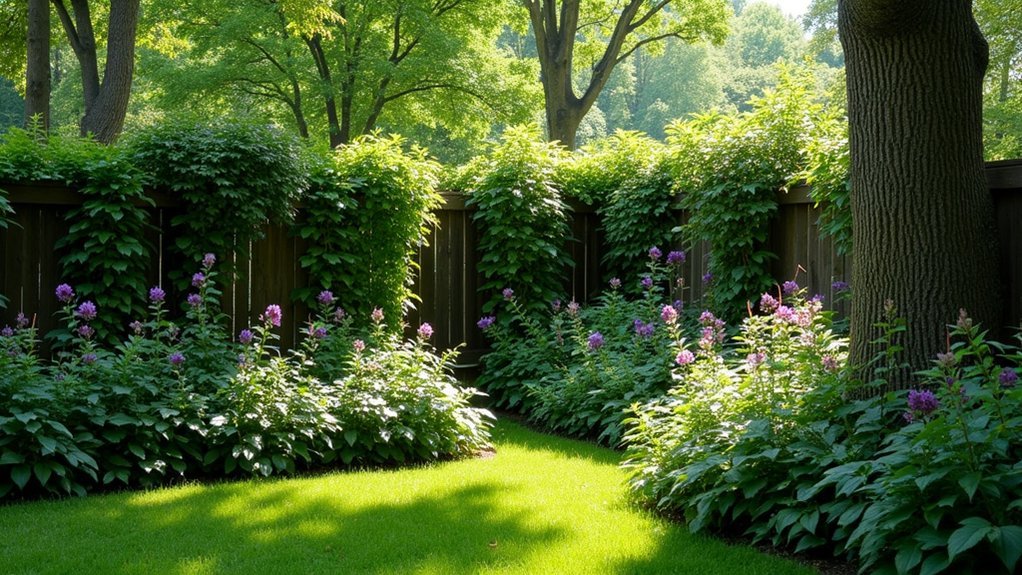
While many gardeners view shade as a limitation, it actually presents unique opportunities for creating vibrant pollinator fences. The key is identifying exactly what type of shade you’re working with—whether it’s partial shade, dappled light, or deep shade—before selecting appropriate plants for shade conditions.
Your boundary’s shade profile affects more than just sunlight; it influences soil moisture levels too. Areas sheltered by structures might be dry, while tree-canopied spots often retain moisture. When planning your pollinator garden, consider these microclimates carefully.
Remember that many pollinators, including native bees and hummingbirds, willingly forage in shadier environments if suitable flowering plants are available.
Benefits of Shade-Tolerant Plants for Pollinator Corridors
Although often overlooked, shade-tolerant plants serve as critical lifelines in pollinator corridors, creating food highways where sunlight is scarce.
When you incorporate native shade-tolerant plants like Columbine and Woodland Phlox into your garden boundaries, you’re supporting local pollinators that have evolved to thrive in these filtered-light environments.
Your shade gardens extend the blooming season throughout your property, ensuring bees, butterflies, and other beneficial insects find nourishment all season long.
These pollinator plants also help maintain soil moisture and health, creating microhabitats that support diverse wildlife.
Top Native Species for Shaded Fence Lines
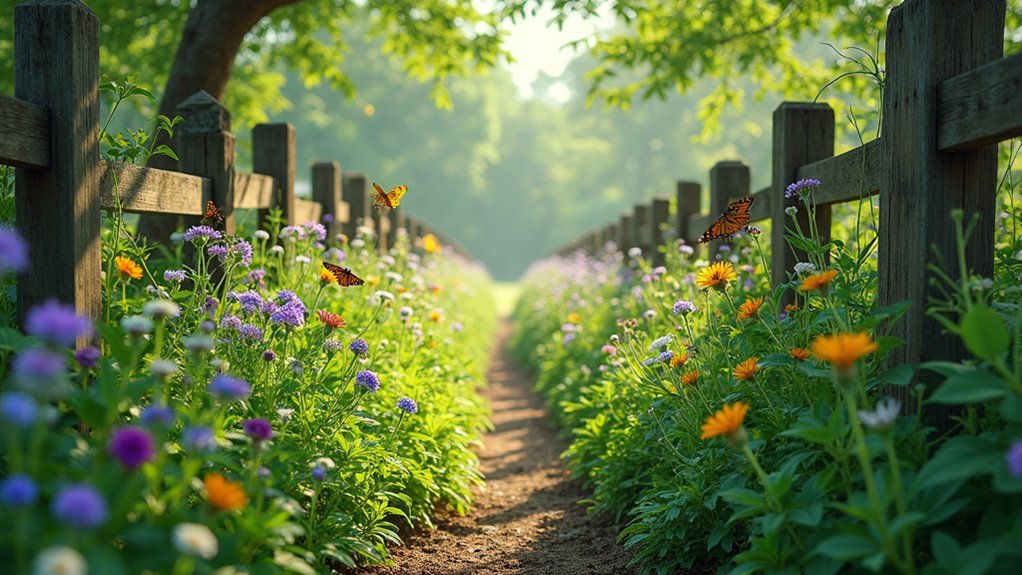
When selecting plants for your shaded fence line, native species offer the best ecological benefits while requiring minimal maintenance.
Virginia Bluebells thrive in full shade and provide vital nectar for early-season pollinators. For striking foliage, consider Coral Bells, which attract both bees and hummingbirds with their sweet nectar.
Woodland Phlox forms fragrant blue mats in your shade garden, creating necessary food sources for butterflies.
In partial sun areas, Pale Purple Coneflower supports diverse pollinator populations and later feeds birds with its seeds.
Bush Honeysuckle serves as an excellent year-round option, featuring trumpet-shaped flowers that attract hummingbirds and vibrant fall foliage.
These native species create a thriving ecosystem along your fence line while turning previously unused space into a pollinator haven.
Creating Multi-Season Blooms in Low-Light Areas
Even in the shadiest corners of your garden, you can establish a continuous pollinator buffet that flowers from early spring through late fall.
Start with early bloomers like Virginia Bluebells, then shift to mid-season stars such as Columbine and Woodland Phlox. For late-season interest, incorporate Pale Purple Coneflower and Coral Bells.
Plant in thoughtful waves of bloom—spring bluebells, summer columbine, and autumn coneflowers—to sustain pollinators through the seasons.
This succession planning guarantees your shade-loving plants provide reliable nectar and pollen sources when pollinators need them most.
By combining Bush Honeysuckle, Astilbe, and other shade-tolerant varieties, you’ll create a dynamic fence line that sustains pollinator activity throughout multiple seasons.
Native species like these not only thrive in low light but also support local biodiversity by offering familiar food sources to bees and butterflies when sunny garden spots have stopped flowering.
Design Principles for Effective Pollinator Fences
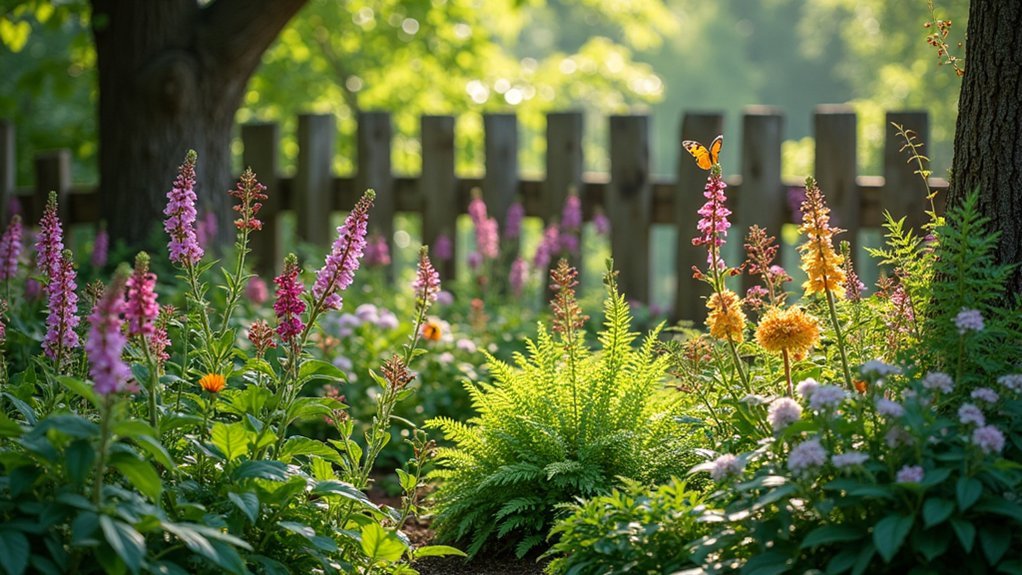
Creating a successful pollinator fence involves more than just selecting the right plants—it requires thoughtful design to maximize both aesthetic appeal and ecological function.
When planning your fence, incorporate layers by combining taller shrubs like Bush Honeysuckle with lower-growing shade-loving plants such as Coral Bells and Woodland Phlox.
Pay close attention to sunlight exposure in your space, as this determines which native shade-tolerant plants will thrive. Virginia Bluebells and Trillium are excellent choices for deeper shade areas and attract local pollinator species already adapted to your region’s conditions.
Design with vertical diversity in mind by including blooms at varying heights. This multi-dimensional approach supports different pollinator species and their unique foraging behaviors while creating visual interest throughout your garden fence.
Establishing Vertical Habitats in Partial Shade
Although many gardeners overlook shaded areas for pollinator support, vertical habitats in partial shade offer exceptional opportunities for ecological diversity.
You’ll find that many native bees actually prefer cooler, shadier conditions than honeybees.
To maximize your space and pollinator activity, layer shade-loving plants vertically. Bush Honeysuckle and Abelia work beautifully along fences, providing both structure and nectar-rich blooms.
Beneath these, incorporate Coral Bells and Woodland Phlox to create multiple flowering tiers that attract diverse pollinators throughout the seasons.
These vertical habitats don’t just solve light limitation challenges—they create essential shelter and nesting spots for pollinators.
Soil Preparation and Maintenance for Shade Gardens
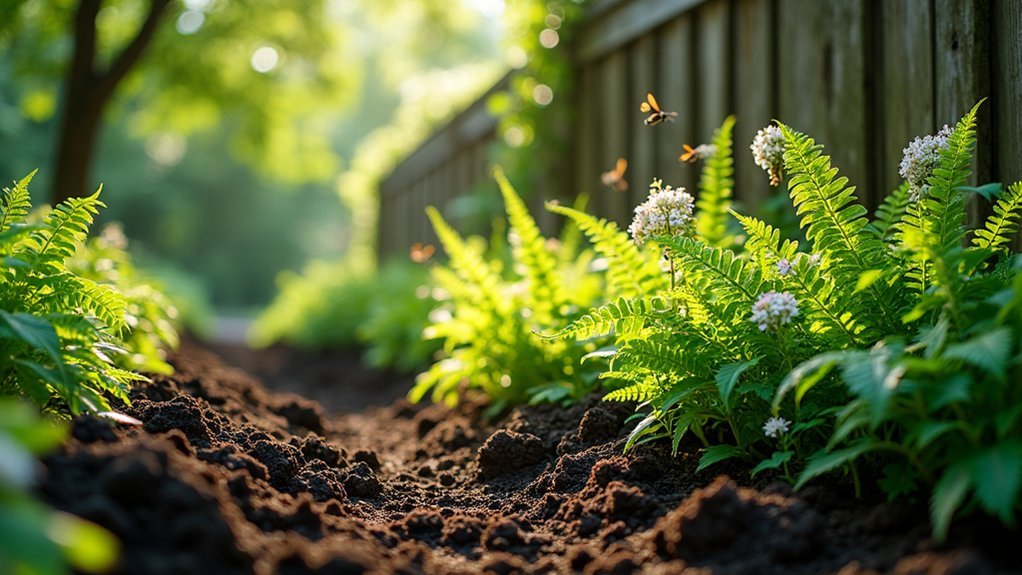
Successful shade-loving pollinator fences start with properly prepared soil, as your plants’ health directly depends on what’s beneath the surface.
Test your soil’s pH and nutrient content—most shade-tolerant species prefer slightly acidic to neutral soil (pH 6.0-7.0).
In shady areas, soil moisture can be tricky to manage. While shade means less evaporation, areas under tree canopies might remain surprisingly dry.
Amend heavy clay or compacted soil with compost to improve drainage while retaining essential moisture. Monitor conditions regularly, as different parts of your fence line may have varying moisture needs.
Apply organic mulch to suppress weeds and gradually enrich your soil as it decomposes.
Including native shade-loving plants in your soil preparation strategy will enhance biodiversity, creating a thriving ecosystem that supports both your plants and visiting pollinators.
Combining Aesthetics and Ecological Function Along Boundaries
The artistry of planting along boundaries comes alive when you blend visual appeal with ecological purpose. Your fence doesn’t have to be merely decorative—it can become a thriving ecosystem that serves both your garden and local wildlife.
| Plant Type | Visual Appeal | Ecological Function |
|---|---|---|
| Flowering Shrubs | Privacy screening | Nesting habitat |
| Herbaceous Perennials | Seasonal color | Nectar sources |
| Native Species | Textural variety | Specialized pollinator support |
Frequently Asked Questions
Do Pollinators Like Shade Plants?
Yes, many pollinators do like shade plants. You’ll find bumblebees thriving in cooler, shadier conditions, while native bees seek refuge from heat in shaded environments with flowering plants like Columbine.
Do Pollinator Plants Need Full Sun?
Not all pollinator plants need full sun. You’ll find many species that thrive in partial shade or dappled light. They’ll still attract bees, butterflies, and hummingbirds while offering necessary nectar and pollen.
What Flowers Are Shade Loving for Butterflies?
For shade-loving butterfly flowers, you’ll have success with Woodland Phlox, Coral Bells, Astilbe, Columbine, and Pale Purple Coneflower. They’ll attract pollinators while thriving in partially shaded areas of your garden.
What Are the Benefits of Pollinator Friendly Plants?
You’ll support declining bee and butterfly populations by providing essential food sources. Pollinator-friendly plants enhance biodiversity, create sustainable ecosystems, and guarantee continued plant reproduction while requiring less maintenance than many ornamental varieties.
In Summary
You’ll transform your shaded fence line into a vibrant wildlife corridor when you choose the right shade-loving natives. By creating these pollinator-friendly boundaries, you’re supporting local biodiversity while solving a common garden challenge. Remember to layer your plantings, prepare soil properly, and select species that bloom across seasons. Your fence won’t just mark a property line—it’ll become a living ecosystem connecting your garden to the wider natural world.

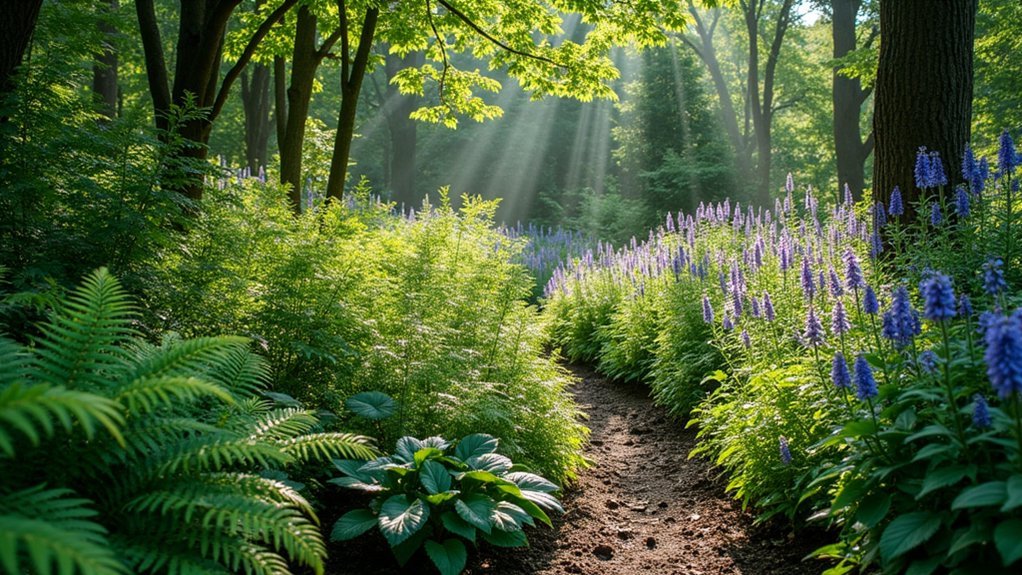



Leave a Reply